![]()
Aroids and other genera in the Collection
Take the Tour Now?
Orchids
The
Exotic Rainforest
Within our collection we have many species of Philodendron. If you are seeking other photos, click this link
The confusion over two rare
Philodendron plants!
Philodendron moonenii
Croat
and
Philodendron 'joepii'
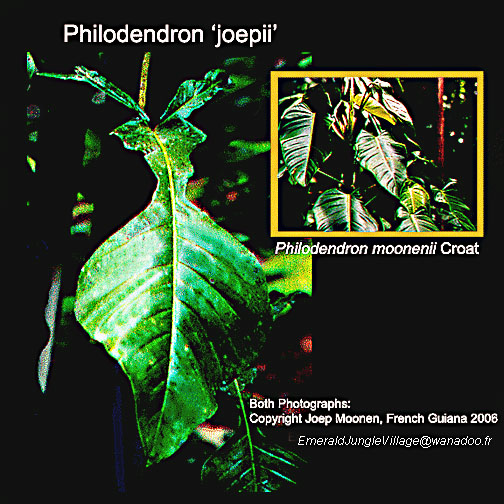
Philodendron
moonenii
Croat
and
Philodendron 'joepii'
Two Rare South American
Philodendron
Both Discovered by Naturalist Joep Moonen
(pronounced yupe)
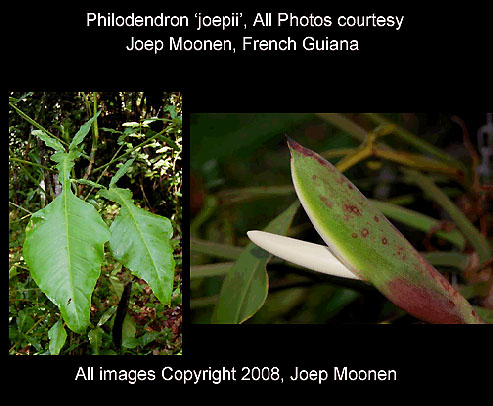 For some collectors, ever since my friend Joep introduced
these plants to the world, "plant nuts" have
confused their identity. The oddest of the pair, the one a visiting
botanist nick named Philodendron 'joepii' (yupe-E-eye), has yet to receive an officially
published
scientific name and will likely never receive one The more oval of the two is the only one bestowed that honor
and is now a published scientific species.
Both bear Joep's names, one his first and one his last.
For some collectors, ever since my friend Joep introduced
these plants to the world, "plant nuts" have
confused their identity. The oddest of the pair, the one a visiting
botanist nick named Philodendron 'joepii' (yupe-E-eye), has yet to receive an officially
published
scientific name and will likely never receive one The more oval of the two is the only one bestowed that honor
and is now a published scientific species.
Both bear Joep's names, one his first and one his last.
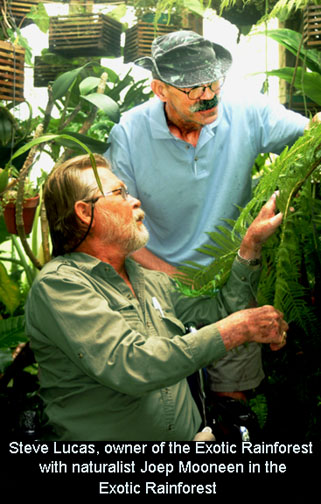 As late as 2007 an ad for the
very interesting tri-lobed 69686 saying "move over Philodendron
moonenii" appeared on an auction forum! P69686 looks nothing like P. moonenii. The seller obviously thought the tri-lobed plant of Joep's
pair was P. moonenii. Sorry, that one is Philodendron 'joepii'. Confusing?
Hopefully this page will clarify the differences.
As late as 2007 an ad for the
very interesting tri-lobed 69686 saying "move over Philodendron
moonenii" appeared on an auction forum! P69686 looks nothing like P. moonenii. The seller obviously thought the tri-lobed plant of Joep's
pair was P. moonenii. Sorry, that one is Philodendron 'joepii'. Confusing?
Hopefully this page will clarify the differences.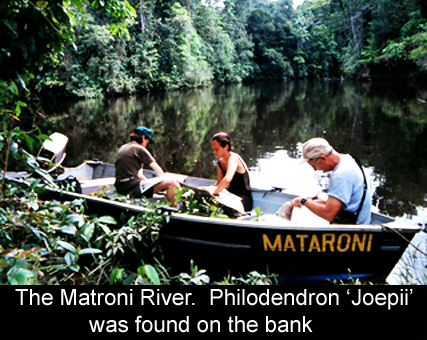 Oiapoque River in the Brazilian state
of AmapÓ. Like most Philodendron species, the species
is variable. An easy to understand explanation of natural
variability
can be found
here.
Oiapoque River in the Brazilian state
of AmapÓ. Like most Philodendron species, the species
is variable. An easy to understand explanation of natural
variability
can be found
here.A part of the Guiana Shield, AmapÓ is a 2.5 hour drive but only 10 minutes by boat from Joep's property, Emerald Jungle Village. According to Joep, Philodendron moonenii is quite rare. The stems are succulent and the specimen is difficult to grow from a cutting. Joep states he has wonderful P. moonenii specimens growing around his property. Adult plants can be seen in flower at E.J.V. every year.
Dr. Croat's scientific description of Philodendron moonenii can be read in Aroideana, Volume 27, the 2004 edition of the International Aroid Society journal. The species is hemiepiphytic with leaf blades 20 to 29.5 cm (app. 8 to 11 1/2 inches) long by 13 to 17.5cm (app. 5 to 7 inches) wide. A hemiepiphyte (hem-a-EPA-fite) is a plant species that can either begin life as a seed which has fallen on the ground and has climbed a host tree or the seed was deposited on a tree in a bird's droppings and has sent roots down toward to the ground. Amazingly, even though the name is famous, the true Philodendron moonenii simply has not reached a high level of popularity with collectors. To most, this form is almost unknown!
 The sought after and very odd Philodendron 'joepii'
with it's wide lower lobe tapering upwards into a slender narrow
upper
body and then topped by a pair of upwardly and outwardly pointing lobes
was found by Joep in 1991 on the Mataroni River in eastern French
Guiana. Joep takes visitors almost daily to the jungle on rain forest ecological tours and was seeking new places on that river for
ecotourism.
The sought after and very odd Philodendron 'joepii'
with it's wide lower lobe tapering upwards into a slender narrow
upper
body and then topped by a pair of upwardly and outwardly pointing lobes
was found by Joep in 1991 on the Mataroni River in eastern French
Guiana. Joep takes visitors almost daily to the jungle on rain forest ecological tours and was seeking new places on that river for
ecotourism.
The plant was seemingly so malformed he first thought it had simply been eaten by insects. But when he returned to the site he found it normally grew in that form. That plant existed on an ant's nest! When he attempted to recover the ant covered specimen he fell into the boat and thousands of ants invaded! Joep was certain he would be eaten by insects! To save both himself and the plant Joep elected to tow the specimen behind the boat for an hour in to get rid of all those ants! Unsure if he had actually found a new species Joep began labeling each new leaf with the date it was collected. He has subsequently found only one additional plant on the river. Two specimens exist in the wild. Only two!
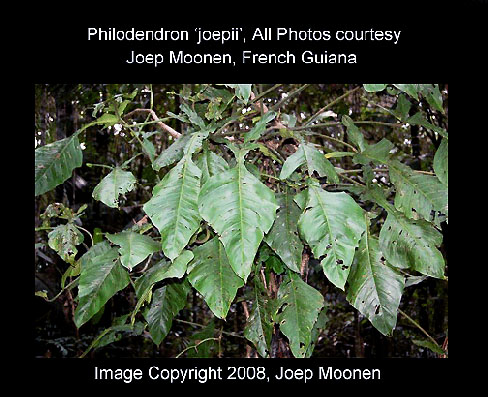 The plant is extremely rare and it's leaves grow to approximately 70 cm
(27 1/2 inches) in length. The specimens at
Emerald Jungle Village
now produce an inflorescence each year. An inflorescence is simply
a spathe and spadix and is the reproductive portion of any aroid. This plant is still under investigation and
has not been officially scientifically identified. Joep has come
to the conclusion it may be a hybrid and made this comment in a recent
email exchange while we were discussing another somewhat similar plant
found at the gardens of Roberto Burle-Marx in Brazil saying it may be "a
natural hybrid
between
Philodendron bipennifolium and Philodendron pedatum.
The 'ears' and inflorescences of 'joepii' look like (those) in
pedatum."
Commenting that both of
these species grew near the natural location of P. 'joepii' he went on
to explain,
"I found only 2
plants in the wild (on the) Mataroni River in eastern
French Guiana,
many Amazonian species there".
In February, 2008
Philodendron 'joepii' bloomed for Joep for the very first time.
But please understand, an inflorescence is not a "flower". It is a
group of flowers, both male and female. The actual spathe is
nothing more than a modified leaf. Production of a spathe and spadix
is quite rare on this specimen.
The plant is extremely rare and it's leaves grow to approximately 70 cm
(27 1/2 inches) in length. The specimens at
Emerald Jungle Village
now produce an inflorescence each year. An inflorescence is simply
a spathe and spadix and is the reproductive portion of any aroid. This plant is still under investigation and
has not been officially scientifically identified. Joep has come
to the conclusion it may be a hybrid and made this comment in a recent
email exchange while we were discussing another somewhat similar plant
found at the gardens of Roberto Burle-Marx in Brazil saying it may be "a
natural hybrid
between
Philodendron bipennifolium and Philodendron pedatum.
The 'ears' and inflorescences of 'joepii' look like (those) in
pedatum."
Commenting that both of
these species grew near the natural location of P. 'joepii' he went on
to explain,
"I found only 2
plants in the wild (on the) Mataroni River in eastern
French Guiana,
many Amazonian species there".
In February, 2008
Philodendron 'joepii' bloomed for Joep for the very first time.
But please understand, an inflorescence is not a "flower". It is a
group of flowers, both male and female. The actual spathe is
nothing more than a modified leaf. Production of a spathe and spadix
is quite rare on this specimen.
Some will certainly say the
information in this article is incorrect, Joep would disagree. Ask
him, his email address is attached. The specimen photos
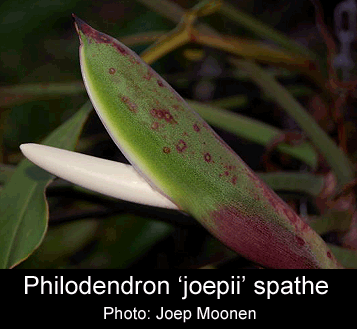 above were
taken by Joep Moonen of wild plants and all the information in this article was provided and
verified by Joep. And we now have specimens in our personal collection of
the rarest plants! Those were imported legally with permits as a result of
our friendship!
above were
taken by Joep Moonen of wild plants and all the information in this article was provided and
verified by Joep. And we now have specimens in our personal collection of
the rarest plants! Those were imported legally with permits as a result of
our friendship!
The images on this page are the Copyright property of naturalist Joep Moonen, French Guiana. You must seek permission before attempting to duplicate any image!
 If you enjoy spending time in a rain forest filled with exotic
creatures and extremely rare exotic plant species Joep Moonen also enjoys introducing
people like you to the
rainforests of northeast South America. The
Emerald Jungle Village website can be found at:
http://home.planet.nl/~gumamaus/
If you enjoy spending time in a rain forest filled with exotic
creatures and extremely rare exotic plant species Joep Moonen also enjoys introducing
people like you to the
rainforests of northeast South America. The
Emerald Jungle Village website can be found at:
http://home.planet.nl/~gumamaus/
For eco-tour information and a brochure contact Joep Moonen directly at EmeraldJungleVillage@wanadoo.fr
Go here for more about P69686, the third plant in this confusion.
Click here for a list of all Philodendron and other species in our collection